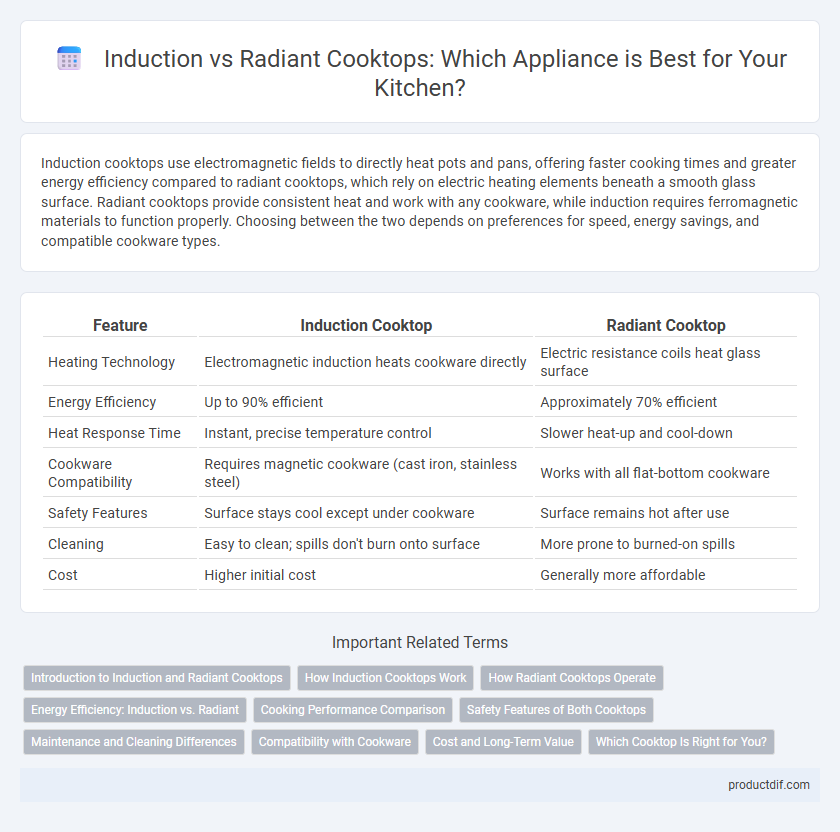Induction cooktops use electromagnetic fields to directly heat pots and pans, offering faster cooking times and greater energy efficiency compared to radiant cooktops, which rely on electric heating elements beneath a smooth glass surface. Radiant cooktops provide consistent heat and work with any cookware, while induction requires ferromagnetic materials to function properly. Choosing between the two depends on preferences for speed, energy savings, and compatible cookware types.
Table of Comparison
| Feature | Induction Cooktop | Radiant Cooktop |
|---|---|---|
| Heating Technology | Electromagnetic induction heats cookware directly | Electric resistance coils heat glass surface |
| Energy Efficiency | Up to 90% efficient | Approximately 70% efficient |
| Heat Response Time | Instant, precise temperature control | Slower heat-up and cool-down |
| Cookware Compatibility | Requires magnetic cookware (cast iron, stainless steel) | Works with all flat-bottom cookware |
| Safety Features | Surface stays cool except under cookware | Surface remains hot after use |
| Cleaning | Easy to clean; spills don't burn onto surface | More prone to burned-on spills |
| Cost | Higher initial cost | Generally more affordable |
Introduction to Induction and Radiant Cooktops
Induction cooktops use electromagnetic fields to directly heat cookware, offering rapid temperature changes and energy efficiency. Radiant cooktops feature electric heating elements beneath a smooth glass surface that transfer heat through conduction, providing consistent warmth. Both cooktops offer sleek designs, but induction units require compatible ferromagnetic cookware, while radiant cooktops work with any type of pot or pan.
How Induction Cooktops Work
Induction cooktops generate heat through electromagnetic fields that directly transfer energy to magnetic cookware, enabling rapid and precise temperature control. Unlike radiant cooktops that use electric heating elements to warm the cooking surface, induction cooktops heat only the cookware, resulting in faster cooking times and improved energy efficiency. This technology minimizes heat loss and offers increased safety since the cooktop surface remains relatively cool during operation.
How Radiant Cooktops Operate
Radiant cooktops operate by heating electric coils beneath a smooth ceramic-glass surface, which then radiate heat upward to the cookware. The heating elements maintain consistent temperatures, allowing precise control over cooking settings. Unlike induction cooktops, radiant models function without magnetic fields and can heat any type of cookware, including glass and aluminum.
Energy Efficiency: Induction vs. Radiant
Induction cooktops convert nearly 90% of energy directly to the cookware, making them significantly more energy-efficient than radiant cooktops, which transfer about 60-70% of energy through heating elements. The precise magnetic induction technology allows faster cooking times and less heat loss, reducing overall energy consumption. Radiant cooktops, relying on electric coils and glass-ceramic surfaces, emit more ambient heat, leading to higher energy waste compared to the focused induction method.
Cooking Performance Comparison
Induction cooktops provide faster and more precise temperature control by using electromagnetic fields to directly heat cookware, resulting in efficient energy use and consistent cooking results. Radiant cooktops rely on electric heating elements beneath a glass surface, causing slower heat response and less even heat distribution, which may lead to hot spots and uneven cooking. For culinary tasks requiring quick adjustments and uniform heat, induction cooktops outperform radiant models in cooking performance.
Safety Features of Both Cooktops
Induction cooktops offer enhanced safety features by using electromagnetic fields to heat only compatible cookware, leaving the cooktop surface cool to the touch and reducing burn risks. Radiant cooktops rely on electric heating elements beneath a smooth glass surface, which can remain hot after use, posing a higher risk of accidental burns. Both cooktops include safety mechanisms such as automatic shut-off and child lock functions, but induction models provide superior protection due to their targeted heating technology.
Maintenance and Cleaning Differences
Induction cooktops feature a smooth glass surface that resists spills and stains, making cleaning effortless with just a damp cloth and mild detergent, while radiant cooktops accumulate baked-on residue due to exposed heating elements, requiring more intensive scrubbing. Induction models have fewer components exposed to food particles, reducing maintenance frequency and ensuring longevity, whereas radiant cooktops often necessitate regular coil and drip pan cleaning to prevent damage and maintain efficiency. The magnetic technology in induction cooktops also prevents overheating, minimizing wear and tear compared to the higher heat exposure in radiant cooktops that can cause discoloration and surface degradation over time.
Compatibility with Cookware
Induction cooktops require compatible cookware made of ferromagnetic materials such as cast iron or stainless steel to function efficiently, as they use electromagnetic fields to directly heat the pot or pan. Radiant cooktops, which use electric heating elements beneath a smooth glass surface, are compatible with virtually all types of cookware including aluminum, copper, and glass. Choosing the right cooktop depends on cookware material availability and compatibility, with induction offering faster and more efficient heating when cookware meets its magnetic criteria.
Cost and Long-Term Value
Induction cooktops typically have a higher upfront cost ranging from $700 to $1,500 compared to radiant cooktops, which generally cost between $300 and $800. Induction models offer greater energy efficiency and faster cooking times, resulting in lower electricity bills and increased long-term savings. Radiant cooktops may have lower initial expenses but often lead to higher operational costs due to slower heating and less efficient energy use.
Which Cooktop Is Right for You?
Induction cooktops offer faster heating, precise temperature control, and greater energy efficiency, ideal for those who prioritize speed and safety in cooking. Radiant cooktops provide consistent heat with a smooth glass surface and work with any cookware, making them suitable for users seeking versatility and easier cleanup. Consider your cooking style, cookware compatibility, and energy preferences to determine which cooktop best suits your kitchen needs.
Induction Cooktop vs Radiant Cooktop Infographic

 productdif.com
productdif.com